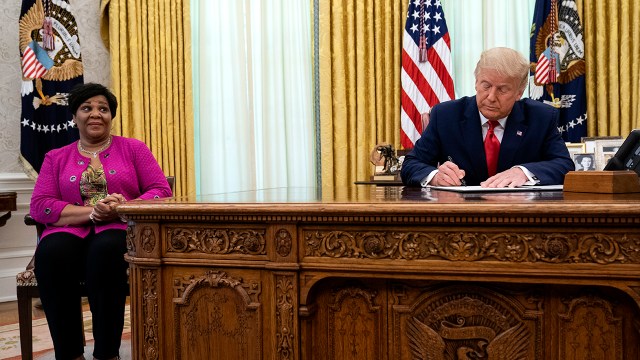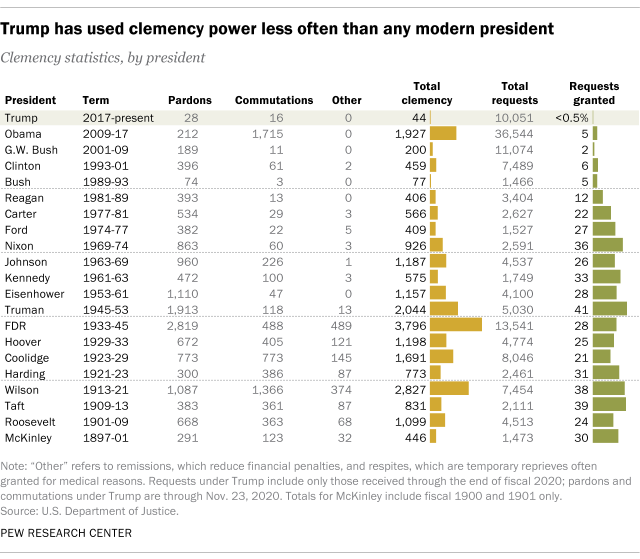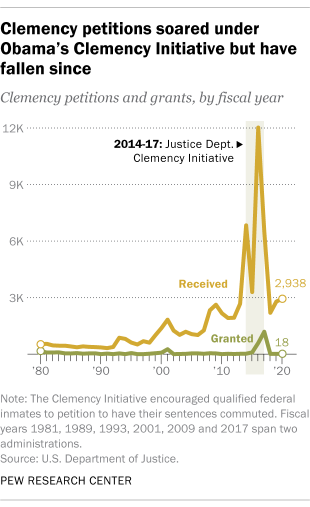BY JOHN GRAMLICH AND KRISTEN BIALIK PEW RESEARCH

As he enters the home stretch of his White House tenure, Donald Trump has used his clemency power less often than any president in modern history, according to data from the U.S. Department of Justice. Trump’s sparse use of pardons, commutations and other forms of official leniency stands in sharp contrast to his predecessor, Barack Obama, who used the clemency power more frequently than any chief executive since Harry Truman.
As of Nov. 23, Trump had granted clemency 44 times, including 28 pardons and 16 commutations. That’s the lowest total of any president since at least William McKinley, who served at the turn of the 20th century. Obama, by comparison, granted clemency 1,927 times during his eight-year tenure, including 212 pardons and 1,715 commutations. The only modern president who granted clemency almost as infrequently as Trump is George H.W. Bush, who granted 77 pardons and commutations in his single term.

Looking at the same data another way, Trump has granted clemency to less than half of 1% of the more than 10,000 people who petitioned him for it through the end of the 2020 fiscal year (which ended Sept. 30), according to the Justice Department. That, too, is the lowest percentage of any president on record, though George W. Bush came close, granting clemency to just 2% of the more than 11,000 people who asked him for it during his eight years in office.
Clemency refers to multiple forms of presidential mercy. The two most common forms are pardons, which forgive past crimes and restore civil rights, and commutations, which completely or partially reduce sentences for those in prison or on community supervision. Two less-common forms are remissions, which reduce financial penalties associated with convictions, and respites, which are temporary reprieves that are usually granted to inmates for medical reasons.
The Justice Department’s statistics, it’s important to note, do not count clemency granted through proclamation or executive order, such as the actions taken by Presidents Gerald Ford and Jimmy Carter to forgive thousands of Vietnam-era draft dodgers. The DOJ numbers also count some clemency recipients twice – for example, in cases where someone received both a pardon and a commutation.
While rare so far, Trump’s use of presidential clemency has caused controversy because of the nature of his pardons and commutations. Many of Trump’s clemency recipients have had a “personal or political connection to the president,” according to a July analysis by the Lawfare blog, and he has often circumvented the formal process through which clemency requests are typically considered.
But Trump is far from the only president who has faced scrutiny over his use of clemency. Obama’s frequent use of commutations, particularly for prisoners convicted of drug-related crimes, prompted criticism from Republicans, who said it benefited “an entire class of offenders” and infringed on the “lawmaking authority” of the legislative branch. And President Bill Clinton drew bipartisan condemnation for pardoning a fugitive commodities trader, Marc Rich, on his last day in office in 2001.
Presidents have generally become less forgiving over time, at least when looking at the proportion of clemency requests they have granted. Every president from McKinley to Carter granted clemency to at least 20% of those who asked for it, according to the Justice Department data. But the percentages have fallen to the single digits for every president since George H.W. Bush, including Obama, who granted clemency to just 5% of those who petitioned him for it.

Obama’s relatively low percentage, however, is largely due to the fact that his administration encouraged federal prisoners to apply for leniency under a program known as the Clemency Initiative. The program, which launched in April 2014 and ended in 2017 when Obama left office, allowed “qualified federal inmates” – those who met certain Justice Department criteria – to apply to have their prison sentences commuted. The initiative led to a surge in petitions and helps explain why Obama’s use of clemency tilted so heavily toward sentence commutations, rather than pardons.
Overall, Obama received more than 36,000 clemency petitions during his time in office, by far the largest total of any president on record. Petitions have declined considerably during Trump’s tenure
John Gramlich is a senior writer/editor at Pew Research Center.













